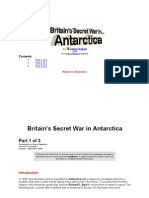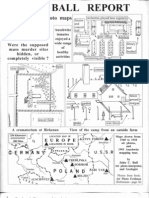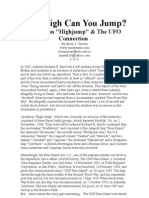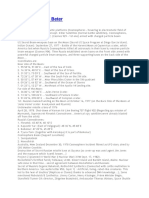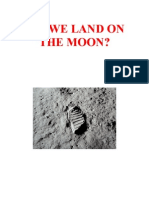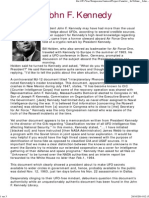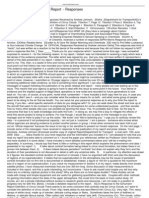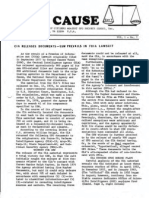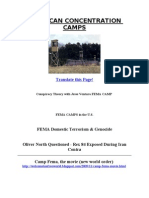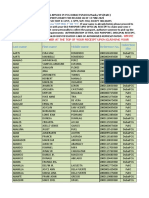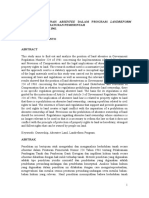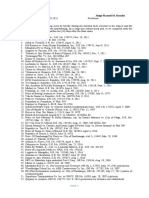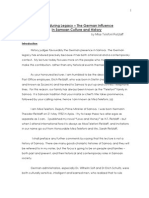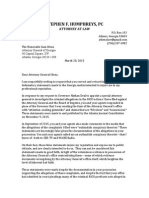Britain War in Antarctica
Britain War in Antarctica
Uploaded by
manetti2007Copyright:
Available Formats
Britain War in Antarctica
Britain War in Antarctica
Uploaded by
manetti2007Original Description:
Copyright
Available Formats
Share this document
Did you find this document useful?
Is this content inappropriate?
Copyright:
Available Formats
Britain War in Antarctica
Britain War in Antarctica
Uploaded by
manetti2007Copyright:
Available Formats
Britain's Secret War in Antarctica
At the end of World War II, Britain sent a covert mission to investigate anomalous activities near its secret base at Maudheim in eastern Antarctica and to seek out and destroy a subterranean Nazi haven. Part 1 of 3
Extracted from Nexus Magazine, Volume 12, Number 5 (August - September 2005) PO Box 30, Mapleton Qld 4560 Australia. editor@nexusmagazine.com Telephone: +61 (0)7 5442 9280; Fax: +61 (0)7 5442 9381 From our web page at: www.nexusmagazine.com by James Robert 2005 Email: james-robert@hotmail.co.uk
Introduction In 1938, Nazi Germany sent an expedition to Antarctica with a mission to investigate sites for a possible base and to make formal claims in the name of the Third Reich. To prepare them for their mission, they invited the great polar explorer Richard E. Byrd to lecture them on what to expect. The following year, a month after hostilities had commenced in Europe, the Germans returned to Neuschwabenland to finish what had been started, with many suggesting that a base was being constructed. Nine years later, Richard E. Byrd, who by now had become an Admiral in the United States Navy, was sent to Antarctica with the largest task force ever assembled for a polar mission. In Admiral Byrd's own words, the mission (code-named Highjump) was "primarily of a military nature".1 Many claim that the task force was sent to eradicate a secret Nazi base in Queen Maud Land, which the Nazis had renamed Neuschwabenland and which had never been explored as profoundly as the rest of the Antarctic. But, and the big but is, the fact that Admiral Byrd spoke of "flying objects that could fly from pole to pole at incredible speeds"2 and with well-documented German activity before, during and in the immediate aftermath of World War II, one can't help but wonder whether there is some truth in the Nazi Antarctica myth. Even so, could Operation Highjump and Byrd's quotes have overshadowed the truth about British excursions in Antarctica by way of misinformation, bringing attention to his mission and,
by doing so, making sure that history only remembered one mysterious Antarctic mission? When the Antarctica mystery is mentioned, Britain is never given more than a footnote. That fact is surprising in itself, especially as British forces were active in Antarctica throughout the war and quite possibly took the initiative in dealing with the Antarctic Nazi threat a whole 12 months before Operation Highjump was initiated. Britain's activities on Antarctica, though less documented and more clandestine, are just as intriguing as the supposed much-vaunted Operation Highjump. Unfortunately for Britain, though victorious in the War, it was bankrupted and humiliated by the two new superpowers. But Britain was in a position to regain some pride and surreptitiously upset its supposed allies with the final, decisive battle against the surviving Nazis: a battle that would never be recorded in the history books; a battle that would make its claims on the continent more legitimate; but, most importantly, a battle that ended the war that it had been compelled to wage. Antarctic Postage Stamps: Claim or Commemoration? On 1 February 1946, a set of postage stamps was released with His Majesty's royal approval. The stamps caused international outrage and brought on a diplomatic crisis for a war-weary Great Britain. The offending eight postage stamps commemorated Britain's claim to the Falkland Islands Dependencies, but one of them also depicted a territorial map of Antarctica that completely overlooked Chile's and most of Argentina's claims on the continent. Now why would Britain, when the world economy was in such dire straits, bring about an international crisis over an area of the world that appeared on the surface to be totally devoid of life? Many historians claim that Britain's postwar interest arose because, with Britain in dire need of materials, Antarctica was deemed as the solution; the stamps were a way of making Britain's claim valid. That assertion, however partially true, does not explain why British forces, as part of Operation Taberlan, were on the continent throughout and in the immediate aftermath of the War. Operation Taberlan was activated as a measure of monitoring German activities on the Antarctic continent. The known British bases were mainly on the Antarctic Peninsula, in places such as Port Lockroy and Hope Bay, and on the islands surrounding the peninsula, such as the secret bases on Deception and Wiencke Islands though some were set up on the continent. The most secret of all has not, and more than likely never will be, disclosed. The base at Maudheim, near the Mhlig-Hoffmann Mountain Range in Queen Maud Land or, alternatively, Neuschwabenland, was so secret that it was never given a name or even a grid reference on official maps. Could the stamps have been released to commemorate a successful mission in Queen Maud Land? The facts and rumours, as well as a story dispensed by a wartime SAS officer, may shed some light on the many mysteries of the Antarctic arena a front that has been kept secret for 60 yearsand on a hostile encounter that will never be divulged to the public.
Britain has suppressed so many wartime events in the name of national security that now, even 60 years on, many people are still none the wiser about the secrets of the warfrom Rudolph Hess to the peace parties, to the even more sinister happenings including Britain's knowledge of the Nazi extermination camps, the Irish Republican Army's flirtation with Nazis, and the lesser known secrets such as SS concentration camps on British soil on Alderney in the Channel Islands. With just those few listed, a pattern of suppression is emergingand on some, a total denial is normally forthcoming. Antarctica is no exception. With the passing of time, all those who served in the Neuschwabenland campaign are no longer with us. The last survivor gave me the following account of the forgotten battle. I hasten to add that the story was told on two separate occasions, 10 years apart, and there was not one discrepancy in either account. [Editor's note: We have deleted opening and closing quotation marks in the next section for ease of reading.] The Neuschwabenland Campaign When Victory in Europe was announced, my unit was resting in a cave in the former Yugoslavia. I was thankful that the War had finally ended, though with war still being waged in the Pacific and tensions rising in Palestine, we were warned that our war could continue. Thankfully, I was spared from participating in the war against Japanbut alas, I was posted to Palestine where the influx of Jews, allied with a rise in Zionist terrorism, was causing anguish not only to the inhabitants of Palestine but also to the British forces that were sent to stem the Jewish influx and quell the uprisings. I was warned that my posting in Palestine would continue indefinitely. I saw many of my fellow soldiers die. Thankfully, I received an order at the beginning of October 1945 to report to my commanding officer, as I had been selected for a mission so secret that none of my senior officers knew why I had been requested to go to Gibraltar. I was not told why I had to report, but I went, hopeful that I would soon be discharged into Civvy Street. How wrong I was: I would be spending another Christmas on a war footing. Once I arrived on Gibraltar I was secreted away by a Major and informed that I would be sent to the Falkland Islands Dependencies for further briefing and that I would be joined by several other soldiers from other elite British forces. The mystery thickened as we were all flown to the Falklands under complete silence. We were ordered to not even speculate about why we had been selected and where we were going. Upon reaching the desolate and forbidding Falkland Islands, we were introduced to the officer who was leading the expedition and a Norwegian who had served in the Norwegian Resistance, an expert in winter warfare who was going to be training us for the mission that we had no inkling about. The Falklands is now considered the best-kept secret in the British Army, and being posted there normally meant an easy few years; however, things were different in the 1940seven more so for those who had been selected with me. We were forced to undertake a gruelling month's training where we were prepared for cold-weather warfare. From being plunged into the icy Atlantic to facing the elements in a tent on South Georgia, the training was arduous and there seemed little sense in the madness that we were forced to undertake. However, after the month's training we were
briefed by a Major and a scientist, and as the mission was relayed to us we all realised that there would be little chance of us all returning, especially if the suspicions proved correct. We were informed that we were to investigate "anomalous" activities around the MhligHoffmann Mountains from the British base in Maudheim. Antarctica, so we were told, was "Britain's secret war". We were then briefed on British activities in the South Pole during the war. We sat intrigued as to what was being divulged; none of us had heard anything so fascinating or frightening. It was not common knowledge that the Nazis had been to Antarctica in 1938 and 1939, and even less known was the fact that Britain began to set up secret bases around Antarctica in response. The one we were to visit, Maudheim, was the biggest and most important as well as the most clandestine Antarctic base of them all. The reason for its importance was the fact that it was within 200 miles of where the Nazis had supposedly built their Antarctic base. We sat there stunned, but still the mystery deepened. We were told about German activity in the Southern Ocean around Antarctica. We were also informed that an inestimable number of U-boats were missing and unaccounted for; but worse, some of those that had surrendered months after the War had ended fuelled even more speculation. British forces had captured three of the biggest names in the Nazi partyHess, Himmler and Dnitzand with their captures Britain was given information that was not going to be shared with Russia or the United States. That information compelled Britain to act alone, and we were spearheading that operation. We were told in no specific terms what was expected of us and what Britain expected us to find on Antarctica. Britain had more than a strong suspicion that the Germans had built a secret base and had spirited many of the unaccounted Nazis away from the turmoil in Europe. Still, more and more revelations were forthcoming. The summer before, we were told, the original scientists and commandos had found an "ancient tunnel". Under orders, the force went through the tunnel but only two returned before the Antarctic winter set in. During the winter months, the two survivors made absurd claims over the radio about "Polar Men, ancient tunnels and Nazis". Radio contact was finally lost in July 1945, and ominously for our mission, going into the unknown, the last broadcast brought us all further anxiety as we listened to the fear in the voice: "...the Polar Men have found us!" was screamed before contact was lost. After the radio broadcast was played, we were then given a rousing speech from the Major who would be leading the expedition to investigate what had happened. "We are to go to the base at Maudheim, find the tunnel, investigate the enigma of the Polar Men and the Nazis and do what we can to make sure the Nazi threat is destroyed." When asked for questions, we all had so many, and thankfully the answers were honest and direct. We were informed that evasive action was being taken because Britain was well aware of US and USSR intentions in mounting their own expeditions, and Britain did not want to risk the chance that the US or the USSR would discover the base and gain further Nazi technology. Both countries had a technological advantage over Britain because of the scientists, equipment and research both countries had recovered. Nevertheless, Britain wanted to be the nation to destroy the menace because Britain
viewed Antarctica as under the British Empire's jurisdiction, and if the Nazis were there it was their duty and their desire to eradicate them first and thus deny both the USA and the USSR the propaganda value of fighting the last battle of World War II. We were flown to the pre-designated drop-off point which was 20 miles from the Maudheim base; snow tractors had already been despatched and were awaiting our arrival. After parachuting into the icy wilderness, full of fear and trepidation, we reached the snow tractors and from that moment on we were on a war footing. We had to operate under complete radio silence. We were alone, with no back-up and no chance of retreat if our worst fears were confirmed. We approached the base wary of what was awaiting us, but when we got there the base appeared devoid of life, a ghost town. Instantly, our suspicions were roused, but, just like all the previous campaigns I had fought during the War, we had a job to do and so our personal fears could not shroud our judgement. As we split up to search the base, a trip wire was detonated and a siren sounded, destroying the silence and startling the whole force. A shout was soon heard, demanding us to identify ourselves, but the voice could not be targeted. With our guns raised the Major introduced us to the voice, and then, thankfully, the voice was given a body. The voice belonged to a lone survivor, and what he divulged made us more anxious and had us wishing that there were more troops amongst our ranks. The lone survivor claimed that in Bunker One was the other survivor from the "tunnel" trip, along with one of the mysterious Polar Men that we had heard on the recorded broadcast. Despite obstructions and objections from the survivor, Bunker One was ordered to be opened. The survivor had to be held back and his fear and anguish panicked us instantly, and none of us wanted to be the one to enter the bunker. Fortunately, I was not selected to enter; that honour was bestowed on the youngest member of our unit. He proceeded inside, hesitating slightly as he struggled with the door. Once inside, a silence descended across the base, followed moments later by two gunshots. The door was opened and the Polar Man dashed to freedom. None of us was expecting what we saw, and the Polar Man had fled into the surrounding terrain so quick that only a few token shots were fired. Out of fear and awe at what we had seen, we all decided to go into the bunker. Go in we did, and two bodies were found. The soldier who had pulled the short straw was found with his throat ripped out, and, more heinous, the survivor had been stripped to the bones. What we had witnessed demanded answers; and with our abject anger at seeing one of our unit die within hours of our landing on the continent, our anger was taken out on the lone survivor who had warned us against opening Bunker One. The whole unit listened categorically to the Major's questions, but it was the answers that were to provoke the most intrigue. The first question that needed answering was just what had happened to the other survivor, and how he had become trapped in the bunker with that Polar Man. However, the lone survivor preferred to start from the beginning, from when they had first found the "tunnel". Whilst he narrated what had happened, the scientist who had accompanied us scribbled down everything divulged. It transpired that the area near the tunnel was one of Antarctica's unique dry valleys, and that was how they managed to find the tunnel with such ease. Every one of the 30 personnel at the Maudheim base was ordered to investigate and, if possible, find out
exactly where the tunnel led. They followed the tunnel for miles, and eventually they came to a vast underground cavern that was abnormally warm; some of the scientists believed that it was warmed geothermally. In the huge cavern were underground lakes; however, the mystery deepened, as the cavern was lit artificially. The cavern proved so extensive that they had to split up, and that was when the real discoveries were made. The Nazis had constructed a huge base into the caverns and had even built docks for U-boats, and one was identified supposedly. Still, the deeper they travelled, the more strange visions they were greeted with. The survivor reported that "hangars for strange planes and excavations galore" had been documented. However, their presence had not gone unnoticed: the two survivors at the Maudheim base witnessed their comrades get captured and executed one by one. After witnessing only six of the executions, they fled to the tunnel, lest they be caught, with the aim to block up the tunnelthough "it was too late; the Polar Men were coming", claimed the survivor. With enemy forces hot on their tail, they had no choice but to try to get back to the base so that they could inform and warn their superiors about what they had uncovered. They managed to get back to the base, but, with winter approaching and little chance of rescue, they believed it was their duty to make sure the secret Nazi base was reported; and so they split up, each taking a wireless and waiting in separate bunkers. One of the survivors tempted one of the Polar Men into the bunker in the hope that they'd believe only one had survived. The plan worked, but to the detriment of his life and to the radio. Unfortunately, the brave soul in Bunker One had the only fully operational wireless radio, which was destroyed in the fracas. The other survivor had no option but to sit, wait and try to avoid going stir crazy. The mystery of who or what the Polar Men were was explained, not satisfactorily but explained nonetheless, as a product of Nazi science; and the enigma of how the Nazis were getting power was also explained, albeit not in scientific terms. The power that the Nazis were utilising was by volcanic activity, which gave them heat for steam and also helped produce electricity, but the Nazis had also mastered an unknown energy source because the survivor claimed: "...after what I witnessed, the amount of electricity needed is more than could be produced, in my opinion, by steam". The scientist amongst the party dismissed most of what was divulged, and rebuked the survivor for his lack of scientific education and implied that his revelations "could not possibly be true". Though the scientist dismissed the survivor's claims, the Major didn't. He wanted to know more about the enemy that we were facing, but, more fundamentally, just what the Polar Man was going to do next. The answer from the survivor did nothing to comfort us and provoked the scientist to announce that the survivor was "certifiable". Disconcerted is too weak a word to describe how we felt when the survivor replied to the Major's questions about the escaped Polar Man's intentions: "He will wait, watch and wonder just how different we taste." On hearing that, the Major issued the battle cry, and guard duty was set up whilst the Major and the scientist discussed, in private, just what we were to do next, even though it was obvious to the rest of us. The next morning we were ordered to "investigate the tunnel", and for the next 48 hours we made our way steadily to the dry valley and the supposed "ancient tunnel". Upon
arriving in the dry valley we were all amazed, for we had been told that Antarctica was completely ice-bound and yet here we were in a valley that reminded me of being back in the North African Sahara. We were forbidden from even approaching the tunnel until the temporary base camp had been erected; and whilst the men constructed the base, the scientist and Major investigated the tunnel. After a few hours, they returned to the now complete camp to chronicle what they had seen and what our next plan of action was to be. The tunnel was not an ancient passageway at all, claimed the scientist, although the Major added that the walls were made of smooth granite and looked infinite. We were informed that we would be able to make our own minds up after we had rested for the night. Sleeping in Antarctica during the summer months was difficult with perpetual daylight covering the continent; but that night, sleep was even more difficult to come by with all the thoughts running through each of our minds about what we would find and just when, or where, we would encounter the Polar Man again. Just before we were assigned our times for guard duty, we were informed that we would be following the tunnel all the way"...to the Fhrer, if needs be". That night our fears were confirmed, as the Polar Man did indeed return. However, this time no more casualties occurred [on our side], but the Polar Man was slain as he was lured to the camp. The scientist decided that the Polar Man was "human" but, it seemed, had been able to produce more hair and withstand the cold far more effectively. The corpse, after a brief post-mortem, was stored in a body bag, and with the cold could be preserved until a more meticulous dissection could occur. The next morning it was decided that two would remain at the tunnel's entrance with the corpse, the tractors, the equipment but, more fundamentally, the radio. The Major, leading the expedition, needed the Norwegian for his expertise and also the scientist; the survivor, too, was critical for the mission's success. The rest of us wanted to join them. I was selected with the other jubilant four who would be undertaking one of the most exciting and possibly one of the most important expeditions in human history. The two who were kept behind were disappointed, but their roles were just as vital to the mission's success as the nine who would be traversing into the unknown. As the nine of us prepared to enter the tunnel, we made sure that we took enough ammunition and explosives to wage a small war and hopefully destroy the base in its entirety, for that was our mission: not to salvage, but to destroy. We walked into the darkness, and thankfully after four hours of walking we began to see some light in the far distance. However, the light was still another hour away; and as each of us battled with our mind's questions of what we would uncover, we inched forward. Eventually we reached the vast cavern that was artificially lit. We were then led to where the survivors had witnessed the executions. The survivor stated it was as covert as one could possibly have wished for. As we looked over the entire cavern network, we were overwhelmed by the numbers of personnel scurrying about like ants, but what was impressive was the huge constructions that were being built. From what we were witnessing, the Nazis, it appeared, had been on Antarctica a long time. The scientist jotted down everything he could, drew diagrams and took rock samples as well as the odd photograph. The Major, on the other hand, was more interested in how the base was to be destroyed without
being caught by the Nazis present. After two days of vigilant reconnaissance, the scientist and Major decided on the targets for the mines. The mines were to be placed all around the roof of the cavern, with other targets on the to-do list such as the generator and the petrol dumps and, if possible and attainable, the ammunition dumps. Throughout the day, mines were laid and more photos were taken; and with the odds of not being detected looking good, a hostage was taken, as well as proof of the Nazi base, the "Polar Man" and photographs of new, and quite advanced, Nazi technology. When the mission to place the mines that would destroy the base had been accomplished, as well as substantial proof of the base gathered, we headed towards the tunnelbut, alas, we were spotted, and more of the Polar Men and a troop of Nazis gave chase. Upon reaching the tunnel, we needed to put an obstacle in the way to slow down our enemy long enough for the mines to detonate. Some mines were placed at the entrance to the tunnel, and when the explosions were heard we were hopeful that not just the base had been comprehensively destroyed but so, too, the enemy forces giving chase. We were wrong. The mines did indeed close the tunnel, but, for those Nazis and Polar Men behind, the chase was still on. In a fighting retreat, only three of the 10 escaped the tunnel: the Norwegian, the scientist and myself. The rest had fallen gallantly in making sure that some of the party survived. Upon reaching the safety of the dry valley, enough mines were laid to close the tunnel permanently. After the mines were detonated, there was no evidence of any tunnel ever existing. Suspiciously, very little of the evidence unearthed remained. Whether it had been lost accidentally or purposely, it mattered little because the scientist had already made his and, ultimately, the mission's own conclusions. The camp was disbanded and we returned to the Maudheim base where we were evacuated and flown back to the safety of the Falkland Islands Dependencies. Upon reaching South Georgia, we were issued with a directive that we were forbidden to reveal what we had seen, heard or even encountered. The tunnel was explained away as nothing more than a freak of nature; "glacial erosion" was the scientist's specific term. The "Polar Men" were nothing more than "unkempt soldiers that had gone crazy"; the fact that they were German was never submitted into the report, and any notion of the mission going public was firmly rebutted. The mission would never be made official, though certain elements of the mission were to be leaked to the Russians and the Americans. So my last Christmas of World War II was spent on the Antarctic continent in 1945, fighting the same Nazis that I had fought against every Christmas since 1940. What was worse was the fact that the expedition was never given any recognition, nor the survivors any credit. Instead, the British survivors were de-mobbed from the forces, whilst the scientist and his report would soon disappear, the mission never to be known about except by the select few. That mission never made the history books, but the return mission in February 1950, conducted by a joint BritishSwedishNorwegian expedition that lasted till January 1952, did. The main purpose of the expedition was to verify and investigate some of the findings of the 193839 Nazi expeditions to Neuschwabenland.
Five years after our mission, Maudheim and Neuschwabenland were revisited, and that expedition had everything to do with the Neuschwabenland campaign, but, more importantly, with what we had destroyed. For the intermediate years between the missions, the Royal Air Force continuously flew flights over Neuschwabenland. The RAF's official reason for their extensive flights was that they were searching for suitable places to set up base camps. However, one can't help but wonder.3 [The SAS officer's account ends here. Ed.] How Britain Gained the "Knowledge" My U-boat men, six years of U-boat warfare lie behind us. You have fought like lions. A crushing superiority has compressed us into a narrow area. The continuation of the struggle is impossible from the bases that remain. U-boat men, unbroken in your warlike courage, you are laying down your arms after a heroic fight which knows no equal. In reverent memory we think of our comrades who have sealed their loyalty to the Fhrer and Fatherland with their death. Comrades, maintain in the future your U-boat spirit with which you have fought at sea, bravely and unflinchingly, during the long welfare of our Fatherland. Long live Germany! Your Grand Admiral. Grand Admiral Dnitz, 4 May 1945, ordering his U-boats to start their return journey. With 16 German U-boats sunk in the South Atlantic area between October 1942 and September 1944, and with most of those sunk engaged in covert activities, Britain had long since been aware of Neuschwabenland being a possible base, but it was not until after the war in Europe had ended that the world awoke to the possibility. On 18 July 1945, newspapers around the world focused their headlines on Antarctica. The New York Times stated "Antarctic Haven Reported", whilst others claimed that "Hitler had been at the South Pole".4 These headlines which shook the world were based, in part, on fact. The news reports and events happening in South America made the world sit up and take notice, not least the military forces of the United States and Great Britain. On 10 June 1945, an unmarked German U-boat surrendered to the Argentine Navy; no further details were released. The whereabouts of at least a hundred other U-boats were still a mystery, as renowned historian Basil Liddell Hart noted: "During the early months of 1945 the size of the U-boat fleet was still increasing... In March, the U-boat fleet reached its peak strength of 463 [emphasis added]."5 The mystery deepened when, on 10 July 1945, the German U-530 surrendered at Mar del Plata, Argentina, and it only took eight days for the world to know. However, the Uboat mystery did not end with U-530; just over a month later, on 17 August 1945, U-977 also surrendered at Mar del Plata. Even more curious was the fact that the same month, U-465 was scuttled off Patagonia. Only three months after the Kreigsmarine's U-boat's strength had peaked, the first of the unaccounted-for U-boats appeared. Unfavourably though, historians tend to gloss over the enigma of the missing U-boats and Hart also offers no explanation other than to
explain the 362 known U-boats' fate: "After Germany surrendered in May, 159 U-boats surrendered but a further 203 were scuttled by their crews. That was characteristic of the U-boat crews' stubborn pride and unshakeable morale."6 With so many U-boats missinga minimum of 40 were estimated missing at the end of the Warand with Britain still possessing one of the world's largest navies and strategically based territories in the Falklands and Antarctica, Britain was the most ideally placed of all the Allies to deal with a Nazi haven. It would have been the best informed about the missing U-boats due to its southern hemisphere territories and an empire that, though crumbling, was still the largest the world had ever seen. Intelligence soon substantiated the suspicions with the interrogations of the captains of both the U977 and U-530. Captain Wilhelm Bernhard, commanding the U-530, claimed that under Operation Valkyrie-2 his U-boat set off to the Antarctic on 13 April 1945. Under interrogation he divulged just what the mission had involved. Supposedly, 16 crew members had landed on the Antarctic shore and deposited numerous boxes that were apparently documents and relics from the Third Reich. Heinz Scheffer, captain of the U-977, also claimed that his U-boat had spirited relics away from the Reich. However, less plausible is the theory that the U-boat delivered the remains of Hitler and Eva Braun to the South Pole, and other theories that the Holy Grail and the Spear of Destiny were also taken to the Antarctic only cloud the truth. What does help substantiate their story is the little-known fact (which Pravda reported on 16 January 2003) that, in 1983, Special Services seized a confidential letter that Captain Scheffer wrote to Captain Bernhard, and in the letter Scheffer pleads to Bernhard not to publish his memoirs in too profound a detail and, in fact, states his intent for the world not to know the truth: "We all made an oath to keep the secret; we did nothing wrong: we just obeyed orders and fought for our loved Germany and its survival. Please think again; isn't it better to picture everything as a fable? What results do you plan to achieve with your revelations? Think about it, please."7 Another mystery that has never been solved is that of the cargo of mercury contained inside U-859 which was sunk on 23 September 1944 by the British Royal Navy submarine HMS Trenchant in the Strait of Malacca in the Java Sea, so far from home with such an anomalous cargoa cargo that could be utilised as a fuel source. The survivors divulged to their British captors what they had been carrying, and that information would have definitely raised eyebrows when their find was relayed to British Intelligence. The case of U-859 was not an isolated one. Many German U-boats were active throughout the world; many supplied the Japanese throughout the war and, strangely, even after the German capitulation. In July 1945, an unmarked German U-boat, supposedly part of a secret convoy, delivered a new invention to Japanese research and development units. The Japanese constructed and activated the device. The device soared into the sky where, however inauspiciously, it burst into flames. It was never
dared to be built again. The British Navy, having already retrieved many of the U-boats that had surrendered in Norway, was well aware that many more had fled, especially if the tale reported in the Latin American press about a German U-boat convoy totally annihilating the British destroyers that engaged the convoy is to be believed. On 2 May 1945, El Mercurio and Der Weg claimed that the final naval battle of World War II between the Kreigsmarine and the Royal Navy had been won by the Kreigsmarine, and that the story had been suppressed in the Western press for fear of stimulating German resistance. Only one destroyer was reputedly spared and the Captain was reported as declaring, "May God help me, may I never again encounter such a force".8 Though the story has been suppressed and the British Government would never admit to the event, rumours of the naval battle are whispered amongst ex-servicemenbut alas, very little of the rumour is substantiated. The missing U-boats were part of the Antarctic jigsaw puzzle that Britain had been putting together since the Nazis first sent Admiral Ritscher on his Thule-sponsored polar mission. And with Britain's Intelligence networkthe SOE (Special Operations Executive) and the SIS (Secret Intelligence Service)providing virtually all the information to the Allied Forces via the Enigma machine9 and its immense European spy network during the War, the picture was appearing slowly. One prime example of Britain's Intelligence excelling was in how much Britain knew about the Nazi's secret atomic weapons programmes which, in turn, helped the RAF bomb the Nazi's secret research station at Peenemnde in the Baltic Sea. The Germans were at a loss to how the British had even heard about it, let alone been able to bomb it. Continued next issue... About the Author: James Robert is a civil servant with an agency of the UK Ministry of Defence, as well as a World War II historian and writer. He has travelled extensively throughout North Africa and Europe to investigate mysteries of Britain's secret wars. With a family from a military background, and with German sources giving many so-called "myths" credence, he has set a personal mission to delve deeper into the strange, suppressed, little-known and anomalous activities that were conducted before, during and after the war against Germany. "Britain's Secret War in Antarctica" has been taken from his forthcoming book that will document some of his investigations. James Robert can be contacted at james-robert@hotmail.co.uk. Endnotes 1. Admiral Byrd's press release, 12 November 1946. 2. El Mercurio, 5 March 1947; Admiral Byrd interviewed by Lee van Atta. 3. Former British SAS officer, documenting the 194546 Neuschwabenland campaign. 4. Le Monde, 18 July 1945. 5. Hart, Basil Liddell, History of the Second World War, Cassell, London, p. 410.
6. ibid., p. 411. 7. Pravda, 16 January 2003, citing a confidential letter from Scheffer to Bernhard. The letter, dated 1 June 1983, was seized by Special Services, whom a German source claims were from the former German Democratic Republic (GDR) and sent at the USSR's behest. 8. The Captain cited by El Mercurio and Der Weg has never been named, nor has the story been given any credence by the British Navy. 9. The Intelligence network performed wonders for the Allies, especially after the capture of an Enigma machine with decoding documents on 9 May 1941; the German U-110 was captured by HMS Bulldog and HMS Aubretia of the 3rd Escort Group. The Germans never discovered the fact that Britain had broken their "unbreakable" codes. However, it was Britain's fortuitous capture which painted the full picture and helped complete the jigsaw puzzle, thus compelling them to take the possibility of a Nazi Antarctic haven seriously before others did.
While some high-ranking Nazis would have known about the haven created in the ice in Neuschwabenland, after Hitler's death it was Grand Admiral Dnitz who held the trump card with his knowledge of U-boat movements. Part 2 of 3
Extracted from Nexus Magazine, Volume 12, Number 6 (October - November 2005) PO Box 30, Mapleton Qld 4560 Australia. editor@nexusmagazine.com Telephone: +61 (0)7 5442 9280; Fax: +61 (0)7 5442 9381 From our web page at: www.nexusmagazine.com by James Robert 2005 Email: james-robert@hotmail.co.uk
Britain's Influential Captures With British forces controlling northern Germany and the ports that went with their sector at the end of World War II, there was a strong likelihood of their capturing most of the Nazi hierarchy. They were also ideally placed because Russia was more interested in Berlin, and the vast US forces were stationed mainly in southern Germany where they had been sent to investigate the supposed "Redoubt". Even so, four years before the end of the war, Britain had managed to apprehend the Deputy Fhrer of the Third Reich, Rudolph Hess, and he was arguably the most knowledgeable of all the Nazis at that juncture. Rudolph Hess landed in Scotland on 10 May 1941 and asked to meet the Duke of Hamilton. His plans for peace talks were quickly rebutted, and so began his 46-year incarceration. Hess's imprisonment is one of the most widely discussed mysteries of the
war. Some claim he was imprisoned because of the damage any revelations he possessed would inflict on the British monarchy. Others claim that Britain's refusal of his peace proposal led to the nation's huge losses territorially, materially, financially and emotionally; because of his silencing, the British people never heard the peace terms or learned how beneficial they may have proved. However, as Christof Friedrich claims,9 some believe that "Hess was entrusted with the all-important Antarctic file"; but whether this was a paper file or a mental note, one thing is for certain: Hess, Deputy Fhrer, would have known everything about the Nazis' Antarctic intentions. Though Hess was dismissed by both Hitler and the British Government as "insane",10 surely Hess's insanity would have restricted his ability in his numerous roles in the Nazi Party and Government. Yet Hess was chief of the Auslandsorganisation, Commissar for Foreign Policy, Commissar for All University Matters and University Policy, Commissar for All Technological Matters and Organisation, and also head of the Office for Racial Policy.11 Hess, in layman's terms, had his "finger in every pie". Rudolph Hess was also an active member of the Thule Society, and his interest in Antarctica would have been on both personal and professional levels. Hess, a keen aviator, used his position in both the Nazi Party and the Thule Society to meet Richard Byrd when he lectured the personnel who were heading for the Antarctic with the Deutsche Antarktische Expedition (German Antarctic Expedition) in 1938, and through his channels Hess would have known everything that had been discovered in Neuschwabenland. Byrd, a living legend throughout the world for being the first man to fly over both the north and south poles, was possibly the most well-informed polar explorer ever, and he divulged his vast knowledge and details of his exploits to the Nazis. Byrd's advice in his lecture and ultimately the Nazis' successful expedition to claim Neuschwabenland may have given the Nazis conviction enough to establish a viable Antarctic base. Hess's flight and eventual capture a few years after the Deutsche Antarktische Expedition meant that plans would have been underway. His enviable position as Deputy Fhrer and his close affiliation with the Thule Society which sponsored the expedition meant, as Canadian journalist Pierre van Paasen claimed shortly after Hess's flight, that "[t]here was no major military plan and secret of the Third Reich of which he was unaware".12 Of his 46 years in prison, Hess spent the first four totally under British jurisdiction. The secrets he gave away in those four years, though dismissed officially as "lunacy" by the British Government and at the Nuremberg Trials, were taken seriously in some quartersparticularly after Britain had caught more of Germany's most powerful Nazis at the end of the war. Unfortunately, with Hess being imprisoned until his suspicious "suicide" in 1987 at the age of ninety-seven,13 all records about him are locked firmly away under the UK Official Secrets Act and will be for the foreseeable future. Only circumstantial evidence can be used to gauge how much or how little Hess knew about the Antarctic haven. Heinrich Himmler, Reichsfhrer of the SS, was captured on 23 May 1945 by the British. Though he managed to kill himself with a cyanide capsule and thus evade interrogation, his entourage did not have that luxury. Himmler was denounced as a traitor by Hitler for trying to make peace with the US and Britain. But as Himmler had nothing to bargain with and his heinous past meant certain execution, could he still have offered the British
information that they desired in the hope of escape or, at worst, a chance to evade the hangman? Unfortunately for him, with no chance of a reprieve and with Dnitz being apprehended the same day, Himmler became an irrelevance; and with his "disgust" at being treated as just a lowly soldier, he announced who he was before inducing his death. Britain nevertheless more than likely gained all the knowledge that Himmler possessed by interrogating his entourage exhaustively. Whatever knowledge Himmler had wished to share, was sharedand without the British having to keep one the vilest men in Europe in their custody. Himmler, labelled a "half crank, half schoolmaster"14 by Albert Speer, had managed to rise from being a lowly poultry farmer to becoming the most feared, reviled man in Europe because of his system of terror, which made mass murder an industry, and because of his faithful paramilitary SS who ensured "loyalty" and "obedience" to the Nazi State. The SS Ahnenerbe missions which Himmler authorised in pursuit of the "ancestral Aryan legacy" to such remote places as Tibet, Egypt and Iraq, and even as close by as the Channel Islands, brought in an inestimable amount of research. And though the 1938 Deutsche Antarktische Expedition was firmly under Hermann Gring's control, Himmler was indeed more than interested in the findings of the expedition and the possibility of discovering an entrance to the fabled Hollow Earthso much so that he surely would have demanded to have been informed for the sake of furthering the Aryan legacy myth. Even so, how much Himmler knew that was not already known by British Intelligence at the end of the war is debatable, though invaluable to the Allies and Britain in particular were the results of the numerous SS Ahnenerbe missions. Even though Dr Ernst Schfer, who led the Tibet Expedition, claimed that "Himmler had some very strange ideas"15 and also that "[t]hey all dabbled in the occult",16 this made no difference to the validity or invalidity of any research or evidence collected. Himmler evaded the hangman's noose by a cyanide capsule, and Gring also used a cyanide capsule on the eve of his execution. Could the pills have been supplied by Britain's SOE in return for information? Hess, Himmler and Gring were all able to commit "suicide" whilst in custodytwo of them being firmly in British custody at the time. All three "suicides" have an aura of mystery surrounding them, especially since the three men would have had some knowledge to share about Antarctica. Hermann Gring, though captured by US forces, still had a fair deal of knowledge about the German Antarctic expeditions of 193839 and 193940, for it was he who commemorated the first expedition with a medal and bragged to the world about the "German success".17 Gring was the Nazi Party's number two for so long, but he managed to cheat death and justice in the most mysterious of circumstances. Born into affluence as a son of a colonial officer, Gring became one of Germany's World War I air aces and ended up highly decorated. He joined the Nazi Party in 1923 and took part in the Putsch, where he established himself in Hitler's favour but also received a groin injury. As a result of this injury, Gring became addicted to morphinean addiction that would have profound consequences. Gring's marriage to a wealthy and influential woman helped him consolidate his
position amongst the elite. His connections to the upper classes assisted the Nazi Party far more beneficially than any parades. In 1932, Gring was elected Speaker of the Reichstag but, despite his popularity, he was making enemies because of his selfobsession, ambition and greed. He became one of Germany's richest men, virtually all his wealth plundered from victims of the Nazis. In 1936, he reached the pinnacle of his career in the Nazi Party when he became Hitler's heir apparent. Yet his popularity had not yet peaked: he would have to wait until the early German success in deploying the Blitzkrieg against Poland for that short-lived honour. But, his addiction was starting to plague his judgement and standing amongst the elite. The early German victories saw Gring rise in Hitler's estimation, but Hitler's fickle temperament was due to change. When Gring's Luftwaffe failed to win the Battle of Britain despite having superior numbers, Gring fell out of favour. He then found solace only in his morphine and his vast, plundered wealth. By 1943, Gring was no longer part of the top Nazi leadership; he was heavily addicted, a virtual recluse and drastically out of favour. Any knowledge about Nazi survival plans that he would have been privy to would have been disputable, but it is highly likely that he would have been able to divulge to US Intelligence enough about Antarctica, learned from his time amongst the elite, to have compelled the United States to consider the possibility of a Nazi base on Antarctica and to take action. Moreover, the Americans would have heard rumours about what the British had discovered. The first Antarctic summer after the completion of the Nuremberg Trials saw Operation Highjump launched; but it is quite possible that the Americans missed the boat because the then most well informed Nazi, Grand Admiral Karl Dnitz, had already been interrogated extensively by the British. Could a secret deal have been struck between Dnitz and Britain? When we look at the facts, it is more than conceivable that a deal was indeed struck. Grand Admiral Dnitz: Key to the Antarctic Haven I believe I fought for a just cause and I refused to run away from my responsibilities when the Nazis, shortly after their final collapse, offered to convoy me aboard a submarine to safe refuge [emphasis added]. Major Vidkun Quisling, Nuremberg, 1945 Grand Admiral Dnitz had taken over the leadership of Nazi Germany, and every Uboat, ship, boat and port still held by the Germans after Hitler's death was under his command. He would have been the perfect successor to orchestrate a tactical escape an escape that would ensure that the German deaths and the research undertaken were not in vain and, in short, that would enable the seeds of a Fourth Reich to disperse. Many Nazis chose to stay and meet certain death, in spite of the Kriegsmarine having the largest submarine fleet in the Atlantic and the navy's willingness to continue the fight from Norway; it was not that they had nowhere to flee, but many yearned for martyrdom and knew that a greater scheme was being implemented: the emergence of a Fourth Reich. Quisling wanted to die as a Nazi and showed no remorse, just as those who were hung at Nuremberg had. Their assuredness came from a warped view that they would be
deemed martyrs. Hitler, Himmler, Goebbels and numerous other high-ranking Nazis committed suicideand taking one's own life has been the norm throughout history when the battle is lost and only public humiliation and execution are certain. Those who committed suicide in Germany's final collapse and those who stood at Nuremberg did so knowing that if they had fled they would have compromised any secret bases or havens as well as the expatriot communities that flourished in South America and throughout the world. The chances of a Fourth Reich manifesting with so many high-profile Nazis in hiding were minimal, and the Germans, meticulous and diligent as ever, knew that fact. Sacrifices had to be made. Grand Admiral Karl Dnitz, Second Fhrer of Nazi Germany, and his government had been legitimised by various countries around the world when Hitler's death and Dnitz's promotion were known. However, his promotion also meant that he was ideally placed to assist the Nazis in their plans to escape Europe. Tried as a war criminal alongside the rest of the Nazi hierarchy, Dnitz was given a reprieve from the death sentence and instead was sentenced to serve 10 years in Spandau Prison in Berlin. Throughout his trial, Dnitz claimed that he had only fought in a legal war and that he was ignorant of any Nazi "atrocities" committed. He also claimed to have no knowledge of the "Final Solution". Albert Speer loathed Nazism and was comprehensively remorseful of his part in the Third Reich, yet he received 20 years! Dnitz, on the other hand, wanted his navy to be totally behind the Nazi movement, so much so that he issued a directive on 14 February 1944, ordering his naval officers not just to accept but to embrace Nazism: "The whole officer corps must be so indoctrinated that it feels itself co-responsible for the Nationalist Socialist State in its entirety. The officer is the exponent of the State. The idle chatter that the officer is non-political is sheer nonsense [emphasis added]."18 Dnitz's light prison sentence is strange in view of his unbridled passion for Nazism, but his directive also contravened virtually every rule amongst the German armed forces. The army's leadership and, to an extent, the Luftwaffe steered clear of politics and focused primarily on the war, but Dnitz asserted that to be "non- political" is "sheer nonsense". His plea for loyalty could explain the unaccounted-for U-boats and why so many were seen in the months and years after the war had endedespecially in light of what Albert Speer noted on 10 December 1947 in Spandau Prison: "For all his personal integrity and dependability on the human plane, Dnitz has in no way revised his view of Hitler. To this day, Hitler is still his commander-in-chief [emphasis added]."19 In Hitler's final political statement, he called for all Nazis "not to give up the struggle in any circumstances, but to carry it on wherever they may be against the enemies of the Fatherland". Hitler then named his successor after denouncing Gring and Himmler as traitors: "I appoint Grand Admiral Dnitz as President of the Reich and Supreme Commander of the Wehrmacht."20 Hitler had chosen his most loyal military officer and the one person whom he believed could restore the Reich's fortunes. As noted by eminent historian Chester Wilmot: "The importance Hitler attached to the holding of these U-boats bases reflected the rising power of Dnitz, who was fast becoming the most influential of his counsellors."21
Hitler favoured Dnitz and was so fascinated about the new U-boats' capabilities and the possibility of turning the tide in the Atlantic that "from the start of 1945 they were almost in daily consultation".22 With the new U-boats being able to stay submerged the entire trip from Europe to South America or Antarctica, the chances of a percentage of the Nazi war machine escaping were vastly improved, as was the ability to deal with the British and American navies. At the Fhrer Naval Conference on 3 January 1945, Dnitz bragged about how the new U-boat fitted with the Schnorchel could "achieve success in waters where Germany was forced to cease operations more than three years ago". Dnitz's 1945 claim was nothing new: back in 1943, he had already claimed that the new U-boats would create "entirely new possibilities"23 and his boasts meant that Hitler ordered the construction of Dnitz's U-boats as a top priority. The faith that the Nazi hierarchy had in the new U-boats never diminished, even as Russian soldiers were streaming into Germany. On 6 March 1945, Goebbels spoke up about the sentiment shared amongst the Nazi elite: "There is considerable hope for us here. Our U-boats must get to work hard; above all, it may be anticipated that as the new type gets into action, far greater results should be achieved than with our old U-boats."24 Goebbels again noted in his war diary how pleased the Nazi hierarchy was: "Clearly, the revival of our U-boat war has made a great impression on the war." Goebbels's perceived "revival" was recorded on 28 March 1945, only a month before his death in supposed desperation! Dnitz, as Hitler's most trusted envoy after Goebbels, was aware of Nazi plans for the East as well as the concentration camps. And though some historians suggest he should never have been tried as a war criminal, in the face of the raft of evidence to the contrary, the only aspect that should raise eyebrows about Dnitz's sentence at Nuremberg is its length. His light sentence was due to his assistance in supplying the Allies with information that was invaluable, especially when he had virtually all knowledge of the mysterious U-boats that were being spotted around the world after the war. Britain, being the nation to apprehend Dnitz, was the main beneficiary of Dnitz's intelligence and, as his arrest on 23 May 1945 was the second time he had been incarcerated by Britain, the British interrogators would have known just which buttons to switch to get the answers they wanted. In 1918, in the closing days of World War I, Dnitz had been taken prisoner by the British Navy. He was sent to a prisoner-of-war camp and then transferred to the Manchester Royal Lunatic Asylum. After extensive psychological tests, he was certified "insane" and was left to be "treated" for a year. In spite of Goebbels's comment that Dnitz was "a very cool and realistic calculator",25 the time Dnitz spent in the lunatic asylum would have left mental scars that would have surfaced if he'd again been threatened with incarceration. That fear and his loyalty to the Third Reich meant he had no choice but to stall on the notion of surrender when, on 1 May 1945, he first heard about his succession after Hitler's death. Dnitz then announced to the Wehrmacht: "Against the British and Americans I shall continue the struggle so far and so long as they hinder me in carrying out the fight against Bolshevism."26
With Dnitz still in command of a large navy and enough Wehrmacht to cause further problems for the Allies, his announcement was a threat that the Western Allies in particular took very seriously; it made them realise that peace was still far from certain and "Unconditional Surrender" might need reassessing. The London Times, the day after Dnitz's announcement, advised caution: "Dnitz may gather a force sufficiently large to cause trouble. The fighting spirit of the navy is probably still high. There is a formidable number of U-boats based on Norway, where the enemy also has 200,000 land forces and some hundreds of aeroplanes. It is thus likely that Dnitz contemplates making his stand there rather than in the overrun Reich or in the southern redoubt now threatened from the north and south. He may delay somewhat, but cannot alter, the decision."27 In light of Dnitz's pledge to continue the fight and the vast force still under his command, and considering Allied fears, could "peace" have been struck a peace that had guarantees for all sides? Dnitz could have asked for Germany to be rebuilt and not humiliated like at Versailles, for the Western Allies to fight the spread of Bolshevism, and for leniency if not clemency from the victors, including a whitewash of his personal wartime history, in exchange for a total surrender and for passing on extremely sensitive intelligence. Only a week after Dnitz had declared that the war would continue whilst Bolshevism persisted, he ordered the surrender of all German forces. All the facts indicate that Dnitz's history has been suppressed, and against all reason Dnitz is still not perceived by mainstream historians as having been a major player in Nazi Germany. Clemency was shown with such a short prison sentence, the communist threat had been realised by the Western Allies, and West Germany rose out of the ashes of May 1945 to become the powerhouse of Europe, with many of the major companies that bankrolled the Nazi Party forming huge conglomerates. Other than formally calling for a German surrender and bringing the war in Europe to an end, Dnitz carried on as President of Germany for a further three weeks and was only arrested on 23 May 1945 by British forces. Dnitz, twice imprisoned by the British and a reluctant admirer of the British naval tradition (which did nothing to dampen his hatred for Britain), was the one person who knew the exact state of play concerning the Nazi U-boats, including the new and formidable Type XXI U-boats. Dnitz was also the one person who would have known where the Neuschwabenland base was and what had been transported there and elsewhere. And with information so vital not just to national security but world security, Dnitz could have chosen to divulge as little or as much as he wished; no matter how minimal or sketchy his intelligence, its value was priceless. Dnitz was an impressive character and in the early stages of the war had impressed Hitler with his loyalty and vision. Dnitz duly received his reward on 31 January 1943 when he was promoted to the position of Supreme Commander of the Navy. In one of his inaugural speeches to a select officer elite, Dnitz claimed that "the German submarine fleet is proud of having built for the Fhrer, in another part of the world, a Shangri-La land, an impregnable fortress".28 This was an impressive statement and one that inspired allegiance in his officers and pride in Hitler and the Kriegsmarine. Dnitz's statement spread around the Kriegsmarine with gusto, for all who heard it believed in the possibility. Whilst researching Third Reich mysteries, I encountered an East German source who
had served in the Kriegsmarine and has first-hand accounts about Neuschwabenland. He claimed: "Neuschwabenland, after Europe, was in ruins and Norway, completely in German hands, became the only viable base of operations. When it was decided that for the German nation surrender was best, those who could, left, and took their chances in the U-boat convoys. "Antarctica was a secret but rumours persisted, and only for the most dedicated was it a haven. Most of those with any intimate knowledge of Neuschwabenland did not see the end of the war, and of those who did, the majority were executed, committed suicide or were sent to the Russian gulags... Only those captured by the British forces fared better, but after interrogation were forbidden to mention their wartime exploits again. The threat of having damaging wartime links brought up kept the Germans silent and helped the Allies suppress the truth."29 The German naval officer who gave the account was captured by the USSR and sent to the Siberia for 15 years; when he returned, it was to a communist East Germany. In contrast, Dnitz served only 10 years and lived in a free West Germany. This has caused the officer bitterness, especially as mainstream historians dare not even write about a Nazi Antarctic haven or Dnitz's passion for National Socialism. When Dnitz spoke of a "Shangri-La land" in 1943, was he telling the truth? With Kerguelen being used as a German U-boat base and Neuschwabenland still in German plans, Dnitz knew that his statement would impress Hitler. Unfortunately though, with most of the documentsincluding speech notes, memoirs and diariesrelating to Nazi plans for Neuschwabenland destroyed, disappeared or archived firmly away, any suggestion of Antarctica being a Nazi haven was laughed off by nervous governments. It meant that to raise the subject was to open oneself up to ridicule. However, Dnitz's speeches leave enough clues to cause one to suspect that a whole chapter from World War II has been purposely suppressed. In 1944, Dnitz announced: "The German Navy will have to accomplish a great task in the future. The German Navy knows all hiding places in the oceans and therefore it will be very easy to bring the Fhrer to a safe place, should the necessity arise, and in which he will have the opportunity to work out his final plans."30 The Kriegsmarine was much travelled, loyal to its cause and daring in its exploits. German U-boats were frequent visitors to the East Coast of America and they travelled under the Arctic ice and even up the River Mersey into the Mersey Estuary in England. But their most interesting exploit was discovering an underwater trench that went straight through Antarctica by way of a connection of subterranean lakes, caves, crevasses and ancient ice tunnels. The Allies took Dnitz's statement seriously, especially after Hitler's mysterious suicide; they were aware that Antarctica could have been the "safe place" that Dnitz had spoken of. The British were already onto it, but the Americans were only compelled into action after Dnitz made a statement in 1946, supposedly during his trial at Nuremberg, boasting of an "invulnerable fortress, a paradise-like oasis in the middle of eternal ice".31 Britain, having already investigated the "invulnerable fortress", assisted the United States by covertly supplying maps of Antarctica, whilst overtly, along with Chile, Argentina and other claimant countries, expressing grievances about the intended
Operation Highjump. Britain's assistance in supplying these mapssimilar to the Norwegian maps utilised by the 1938 Deutsche Antarktische Expeditiondid not paint the full picture. Dnitz's information supplied to the British and the likely destruction undertaken by British forces of the Neuschwabenland base meant that Queen Maud Land (Neuschwabenland) was not reconnoitred meticulously by the Americans. There is no answer to explain this omission, though many have speculated. More than likely it was because the area had been explored so profoundly earlier in the century, but one can't help but wonder whether it was because Britain had been there first, leaving nothing for the Americans to find. However, Operation Highjump still supposedly recovered evidence of other basesthough, similarly to British expeditions on Antarctica, Highjump's true findings have also been suppressed? Dnitz had a unique knowledge of Antarctica, but it was his knowledge of German Uboat ports in Norway and U-boats stationed there, as well as the nexus between Norway and Antarctica, that shed further light on the forgotten Antarctic front. But, whilst the importance of Norway to Dnitz, Hitler and the Kriegsmarine was well known, some of the real reasons for the initial invasion of Norway are less so and add even more of a mystery to the history of World War II and the Antarctic front. Continued next issue... Previous issue... Editor's Note The author advises that Operation Tabalan, referred to in part one of his article, should read Tabarin, and apologises for this error. Operation Tabarin was named after a Parisian nightclub. About the Author: James Robert is a civil servant with an agency of the UK Ministry of Defence, as well as a World War II historian and writer. He has travelled extensively throughout North Africa and Europe to investigate mysteries of Britain's secret wars. With a family from a military background and with German sources giving many socalled "myths" credence, he has set a personal mission to delve deeper into the strange, suppressed, little-known and anomalous activities that were conducted before, during and after the war against Germany. "Britain's Secret War in Antarctica" has been excerpted from his forthcoming book that will document some of his investigations. James Robert can be contacted by email at james-robert@hotmail.co.uk. Endnotes 9. Christof, Friedrich, Germany's Antarctic Claim: Secret Nazi Polar Expeditions, Samisdat Publishers, Toronto, 1979. 10. Hess's insanity is just one aspect of the Hess mystery, and the numerous references to his insanity are too numerous to catalogue. However, it did not prevent him from standing for trial at Nuremberg. 11. Picknett, L., Prior, S. and Prince, C., Double Standards, Little Brown, 2001.
12. Van Paasen, Pierre, Chicago Times, 1941. 13. Britain, France, the USSR and USA took turns to guard war criminals including Hess in Spandau Prison. Hess's suspicious death occurred, so we are led to believe, because the Russians were going to release him when their turn next came around. See Picknett et al., Double Standards, for more detail. 14. Nuremberg Trials (19451946). 15. ibid. 16. ibid. 17. This was reported in the German press on 10 April 1939. 18. Officer Naval Directive, 14 February 1944. 19. Speer, A., Spandau: The Secret Diaries, MacMillan, New York, 1976, p. 81. 20. Hitler's final political testament, 29 April 1945. 21. Wilmot, C., The Struggle For Europe, Wordsworth Editions Ltd, Hertfordshire, 1997, p. 617. 22. ibid. 23. Fhrer Naval Conference, 8 July 1943. 24. Report sent by Goebbels to Dnitz, 6 March 1945. 25. Wilmot, op. cit. 26. Directive to the Wehrmacht, 1 May 1945, reported in The Times, London, 2 May 1945. 27. The Times (London), 2 May 1945. 28. The National Police Gazette, January 1977. 29. The former Kriegsmarine officer was from Dresden and was interviewed in December 2003. I investigated claims that Hitler and Eva Braun's child had been born there in 1942. 30. Officer Naval Directive, 1944. 31. Nuremberg Trials, 1946.
The Antarctica mystery deepens as more details emerge about Norwegian, German, British and American expeditions from the 1930s and nuclear blasts over Queen Maud Land in the 1950s. Part 3 of 3
Extracted from Nexus Magazine, Volume 13, Number 1 (December 2005 - January 2006) PO Box 30, Mapleton Qld 4560 Australia. editor@nexusmagazine.com Telephone: +61 (0)7 5442 9280; Fax: +61 (0)7 5442 9381 From our web page at: www.nexusmagazine.com by James Robert 2005 Email: james-robert@hotmail.co.uk
Did Britain Really "Miss the Bus" in Norway? We are standing here in Norway, undefeated, strong as before. No enemy has dared attack us. And yet we, too, shall have to bow to the dictate of our enemy for the benefit of the whole German cause. We trust we shall from now on deal with men who respect a soldier's honour. General Bhme, German Commander-in-Chief in Norway, 7 May 1945 The primary reasons for Norway's importance to Germany were that its coastlines made exceptional U-boat bases, the Germans needed to secure shipments of Swedish iron ore, and the Vermok hydro-electric plant, which produced deuterium oxide (heavy water), was essential to their atomic research, in which they were leading the world at that juncture. However, there were other reasonsreasons that caused Hitler to review and reverse his stance on preserving Norwegian neutrality. On 14 January 1939, Norway formalised its claim to Queen Maud Land in Antarctica, its course of action forced on it by the imminent German discoveries. Adversely, for Norway, its attempt at pre-empting any German claims failed, and so began a political crisis that led to invasion. The Deutsche Antarktische Expedition, using Norwegian maps, soon realised that the wily Norwegians had omitted the vast, dry areas that it rediscovered on 20 January 1939. The Norwegians, and also the British, had long been aware of ice-free areas but had purposely omitted them on their maps so as to avoid additional claimant countries appearing and the conceivable diplomatic crises that would ensue. When the Germans reported the ice-free areas, they were told to claim the whole area in the name of Nazi Germany. They were ordered to drop stakes with swastikas on them to state their intent for sovereignty: this, the Nazis hoped, would be enough to formalise their claim. Nazi Germany and Hitler cared little about what the world thought: they had already gained Austria and Czechoslovakia, and Antarctica was to be a further extension of the Third Reich. Norway valiantly protested about the German claim and the renaming of Queen Maud Land to Neuschwabenland but, with European nations gearing up for war and the world's attention turning to Poland, Antarctica was forgotten. When war finally broke out in September 1939, most of Germany's eventual conquests declared neutrality. Norway was no exception. Hitler wanted Norway to remain neutral but his War Cabinet, whose opinions he trusted until the tide turned against Germany, persuaded him otherwise. On 20 February 1940, Hitler ordered General von Falkenhorst to lead an expedition force to Norway. Hitler claimed: "I am informed that the English intend to land there [Norway] and I want to be there before them."32 The British prime minister, Neville Chamberlain, famously boasted when he announced that British forces had also landed in Norway that Hitler had "missed the bus" 33. His folly caused his government to collapse, his resignation to be forced and his reputation to be destroyed. Furthermore, by committing troops to Norway, Chamberlain had played into the hands of Hitler and all those inside the German War Cabinet. But had the British mission been a total failure? Operation Weserbung was launched by Germany on 9 April 1940 and Norway was
invaded (Denmark was also invaded that same day). And though the British and Allied forces had to be evacuated in June, they had slowed the unstoppable Wehrmacht enough to help the monarchy, the government and the national treasure be evacuated on board the British cruiser, HMS Devonshire. King Haakon VII represented Norway in exile, and the vast treasures and documents saved were beneficial not just to the preservation of Norway but to British Intelligence. Hitler was furious with Vidkun Quisling, whom he had hoped would aid the Nazis more comprehensively. Quisling ultimately would have no power, and his inability to stop the evacuation of the monarchy, the government and not least the vast treasures and documentation caused Hitler to lose faith in him and declare him a Norwegian traitor. Those who failed Hitler lost their standingHitler made sure of that. Even so, Quisling claimed publicly that he had been offered "safe refuge". Whether the statement was that of a madman or was an honest admission, it echoed the claims of others. Though Hitler had only wished to beat the British to Norway, his War Cabinet knew that Norway was vital to virtually all the branches of Germany's armed forces and was more beneficial to its war effort than any other conquest. Nazi Germany's occupation of Norway brought immense benefits to the Reich. There were thousands of miles of protected fjords for the German U-boats, and there was the possibility of the Nazis exerting pressure on neutral Sweden.34 The Third Reich now had a border closer to the Arctic,35 and there was also the chance to train its soldiers in polar conditions, especially after the acquisition of Spitzbergen,36 much to the pleasure of Himmler and his Ahnenerbe. Best of all, Norway was within striking distance of all Nazi Germany's enemies. Norway and its ports also made marshalling the Arctic Sea and the North Atlantic far more profitable. These benefits, allied with the primary reasons, made Norway a highly prized conquest. However, Germany's occupation was not without problems. Britain heavily financed the Norwegian Resistance and it was due to their cooperation that the Vermok hydroelectric plant was targeted and sabotaged so successfully. Information was passed on a two-way basis and the SOE and SIS were privy to any revelation uncovered. British Intelligence also had access to all the Norwegian Government's files, no matter how "sensitive" the information. Britain at that point stood alone: any information, no matter how trivial, was indispensable. Many Poles had gone to the UK after the start of the German occupation with intelligence on the Germans as well as with one of the first prototypes of the Enigma code-making device. Similarly, with the invasion and occupation of Norway, many fleeing Norwegians brought secrets of the Reich to England. After Britain frustrated Germany in the Battle of Britain and, as a result, instilled hope in the numerous governments in exile, in 194041 it could only fight the Germans in Africa or bomb their cities. But news was soon filtering through about a new front, and one that both the British and Norwegian governments had hoped would never be opened a front for which there was little in the way of contingency plans. On 13 January 1941, German commandos under the leadership of Captain Ernst-Felix Kruder from the commerce raider, the Pinguin, stormed and violently captured two
Norwegian whaling ships. If that had happened around European coastlines, there would have been no mystery because the Germans allowed none of its conquered peoples to sail too far from land; but because the captures took place in the Southern Ocean off Neuschwabenland, the news when it filtered through could only have sent shock waves through both the British and Norwegian governments. However, the mystery deepened further because the subsequent night the German commandos resurfaced and captured three more whaling ships and also 11 catchers. The German Antarctic Fleet was active and prosperingmines they had laid around Australian ports sank the first US vessel lost to enemy actionbut it was the Antarctic coast and islands where they mainly loitered. The Atlantis,37 the Pinguin,38 the Stier39 and the Komet40 were just four of the documented ships that had anomalous reasons for being so far south. All four were eventually sunk by the British Navy, far from Antarctica in various parts of the world from France to the Ascension Islands. Now that the Antarctic Front had been truly opened, Britain increased its Antarctic bases and personnel numbers and even issued a postmark. However, possibly the most important area that demanded a base was in Neuschwabenland, officially known as Queen Maud Land. Through Norway's assistance with information and maps, Britain envisaged Maudheim as the most viable place for a base because it was close enough to be able to spy on German activities and also was within striking distance for a highly trained and disciplined military unit. The seeds for the Neuschwabenland campaign had been sown. From 1941 until the start of the BritishSwedishNorwegian Expedition of 194952, Britain sent at least 12 official missions to Antarcticahalf of them between the end of the war and the beginning of Operation Highjump, led by Admiral Byrd, starting in December 1946. Even more intriguingly, Britain sent no missions from the commencement of Highjump until 1948, during which time the US had Antarctica all to itself. Britain nonetheless was more active in Antarctica during the 1940s than any other nation, yet the only Antarctic mission mentioned in depth by historians is Admiral Byrd's. His mission still overshadows every other mission and is the main focus of attention for many conspiracy theorists. Britain's exertions were and still are totally overlooked; and with Admiral Byrd spreading misinformation, the true conspiracy concerning Antarctica as a Nazi haven was forgotten. After the German surrender, Norway still needed to be mopped up, the possible Nazi exodus needed to be ascertained and the secrets that Norway held still needed more investigation. The discoveries further confirmed that the war had ended just in time, but suspicions were still aroused about the estimated 250,000 missing German personnel including Martin Bormann and thousands of other wanted Nazi war criminals. The enigma of the submarines that were presumed to have been utilised in their escape also required consideration. However, even though a percentage of Germany's U-boats may have fled Norway, what was uncovered was still intriguing and certainly proved that the Germans had made great technological strides. In June 1945, the Washington Post published an article stating that the RAF had found, near Oslo, 40 giant Heinkel bombersaircraft with a 7,000-mile range. The article stated that the captured German ground crews had claimed that "the planes were held
in readiness for a mission to New York".41 The British also requisitioned some of the U-boats held in Norway at the end of the war, including the new Type XXI. Captain Mervyn Wingfield was placed in charge of taking these 25 salvaged U-boats to Scapa Flow and, interestingly, chose the new Type XXI to sail in. Upon returning, he stated that "the Allies had won the submarine war just in time"42a statement reiterated by all the Allies when speaking about the Nazis' new weapons. In the UK, British Intelligence unearthed more of Norway's secrets but suppressed them; Antarctica was no exception. When the Norwegian Government returned to a liberated Norway, Antarctica soon returned to their consciousness, though the Norwegians would have to wait several years to go back there, lest the rumours of a Nazi base were true. On the other hand, Britain decided it had collated enough knowledge about Antarctica to initiate an intense investigationone that had to dispel all fears and hide all evidence for it could not tolerate any more technology or personnel being acquired by the wrong hands, namely, the USSR and the USA. Britain had helped liberate Norway and, as 1945 was drawing to a close, was in the process of "liberating" Queen Maud Land (the new atlas of the post-war world no longer recognised Neuschwabenland). However, the mysterious wartime expeditions conducted by all the combatant countries, especially Germany, were not entered into the World War II history books. A travesty of history had occurred. Postwar Power Plays In the immediate aftermath of World War II, suspicions surfaced and rumours spread, and the new enemyone that Hitler had hoped to annihilatewas communism. Allies became enemies, whilst former enemies became allies in the battle against communism. And whilst the USA was offering huge financial subsidies to Western governments to keep them communism-free, Britain was left alone to clean up the last remaining Nazi outposts. When German forces surrendered in May 1945, peace should have broken out but, alas, the world was thrown into a turmoil that was every bit as volatile as it had been before the most violent war in humanity's history began. The year 1945 was not just the year that World War II ended but also the year that the Cold War started in earnest; and whilst the USSR and the USA had fears about each other's intentions, they also had differing ideas for how Germany was to be administered. The problems started at the Yalta Conference of 411 February 1945, but were heightened by the end of the war in Europe when the misinformation and secrecy about the Allies' discoveries made the partnership that had destroyed Nazism no longer tenable. The atmosphere that surrounded Germany in May 1945 following the Nazi surrender was one of exhaustion; but whilst the Western Allies were so fatigued by the war effort, Stalin was not going to give up his territorial gains and was prepared for war and, indeed, fully expected it. The Soviets did nothing to allay the fears that a Nazi haven had been built or that Hitler might not have committed suicide but, instead, had escaped.43
Just before Berlin fell to the Soviets, it was reported that Martin Bormann had discussed Tierra del Fuego, Argentina, with Grand Admiral Dnitz. This conversation that emanated from Hitler's Berlin bunker was one of the last to be intercepted in the war in Europe. Argentina had long been perceived as a haven for many escaping Nazis, but this possibility was long denied by the sympathetic Perons. Yet, with the Soviet General Zhukov and Stalin disagreeing as to whether Hitler was dead or had fled, the Nazi survival myth gained momentum. Britain, in the unique position of holding the strategically important Falkland Islands, was the only country in the immediate months after the war that was in a position to investigate the leading Nazis' claims about an Antarctic haven and the rise of a Fourth Reich in South America. The USA, distracted by the war against Japan and the brewing Cold War, had been caught short by Britain's Antarctic exertions and humbled by its aggressive stance. So the Americans soon adopted a policy, dreamt up during the war, that would destroy Britain's imperial aspirations, hinder every attempt by Britain to exert any influence around the world and make the country an "ally" in name only. However, as early as 1942, Britain and British identity were suffering as a result of the United States' globalisation agenda. It must be remembered that Britain was denied its own atomic bomb, despite the fact that the bomb could have not been created without British expertise. Furthermore, the British people faced worse rationing than any other Western nation, lasting direfully until the 1950s, and Britain was also pressured into giving full independence or self-government to most of the territories in its Empire. So, whilst Britain went into World War II a superpower, by the end of the war and by the actions of American foreign policy, especially Operation Highjump, it had been put firmly in its place. The United States became the only country that could successfully influence Britainas the 1956 Suez crisis proved. Even now, 60 years after the end of World War II, British blood is still being shed on behalf of US foreign policy. Exploring Queen Maud Land As discussed in part one, the Nazi "Shangri-La" did exist. Of unknown size, it was set up during the 193839 Deutsche Antarktische Expedition. The existence of a Nazi Antarctic base hidden in vast caverns was considered feasible enough for the British to set up bases in many parts of Antarctica during the war in response to the threat. And whilst the officially recorded British expeditions mainly concentrated around the Antarctic Peninsula, those not recorded were those that concentrated on investigating Queen Maud Landso named by Norwegian whalers prior to 1939 in honour of Queen Maud of Norway (18691938), consort of King Haakon VII and formerly Princess Maud of the United Kingdom, a granddaughter of Queen Victoria. The Norwegians began exploring Queen Maud Land intensively in 1930, and using planes for the first time they photographed and sketched the area. In subsequent flights in 1931 and 1936, they uncovered areas unknown and identified anomalies that would attract worldwide interest. On 4 February 1936, Lars Christensen dropped the Norwegian flag from his plane, thus claiming the land informally. The maps produced from the photographs omitted the dry areas and lakes that had been identified, but the
discoveries led to private discussions between the Norwegian Government and the Monarchy as to whether Norway should annex the area. After much deliberation, on 14 January 1939six days before the first Deutsche Antarktische Expedition flight over Queen Maud Landthe Norwegian Government passed a royal decree annexing the region between Enderby Land and Coates Land as Queen Maud Land. The Deutsche Antarktische Expedition discoveries were well publicised. Captain Ritscher and his two Dornier Wal flying boats (Boreas and Passat) flew extensively and produced in excess of 1,500 photographs that covered an area of over 250,000 square kilometres. However, as with the strange case of the suppressed Norwegian maps, most of the films, records and research materials were destroyed in the war, though some have since resurfaced. During the war and up till the end of the Antarctic summer of 1945 46, Britain's RAF was also flying over Antarctica to map the area and search for suitable places to establish bases. It discovered more dry areas and possibly even the intelligence that provoked Britain's Neuschwabenland campaign. Britain's arrogance in committing troops to Antarctica, independent of the United States, and in celebrating the feat with the release in February 1946 of a provocative stamp set, would inevitably lead to Britain's claims on Antarctica being contested, even though the stamps commemorated Britain's final fight with Nazism rather than being a statement of its Antarctic claims. And even though Britain expressed outrage publicly when Highjump was launched, it was just a pretence: privately, Britain knew that the USA's newfound superpower status meant that it would not permit Antarctica to be utilised by other nations for financial gain. Britain halted its Antarctic flights and operations for two years, giving the United States a free hand in Antarctica with the commencement of Operation Highjump. With the Nazi haven destroyed, there was little need for the British to return: the Americans would not discover anything that had not already been discovered. Or would they? In the two years they had to discover as much about Antarctica as possible, the Americans found dry areas and warm-water lakes that provoked immense media interest, but Operation Highjump, which they'd planned to last for six months, ended after just eight weeks. They received a hostile reaction from other nations, but it was only after the mission's return that the rumours and theories began to abound and the enigma surrounding Highjump really began. The US conducted another expedition, Operation Windmill, in the Antarctic summer of 194748 and mapped additional areas of special interest. The RAF returned in 194849 and flew extensively in search of a viable base in Queen Maud Land for the joint Norwegian BritishSwedish Expedition (NBSE) that was going to last from 1949 to 1952 and whose objective was to investigate and verify the 1938 German discoveries. Britain and Norway knew that the area of Queen Maud Land which the Nazis had utilised would be vastly different from that which was mapped in the 1930s and early 1940s. An explosion of sufficient magnitude could have created a warm front. The ground could have warmed enough for rising heat to have created precipitationhow
much could only be gauged by the velocity of the explosion. In all probability, snow would have fallen on areas that had not seen water for thousands if not millions of years and the landscape would have changed significantly. When NBSE team members inspected the area, they found the largest land animal (bar penguins) on the continent: tiny mites. That discovery was an irregularity in itself. The expedition also discovered unusual lichens and mosses in certain areas. However, the lakes that had been so prevalent in reports from previous expeditions were largely not noted; nor were the vast, dry areas. Could the lakes have frozen and the majority of the dry areas have disappeared under a blanket of snow? Meantime, more and more countries wanted their own bases in Antarctica, and soon skirmishes started. In November 1948, Britain's Hope Base on the Antarctic Peninsula was suspiciously destroyed by fire; in 1952, Argentinian forces shot at the British returning from the joint expedition. Details of other skirmishes unfortunately have been suppressed for diplomatic reasons. However, in 1982, Britain went to war against Argentina over the Falkland Islands (the Malvinas). Its defeat of the Argentinian forces led to the collapse of the fascist military junta that had dominated Argentina for several years. Argentina also had more than a passing interest in Antarctica but, with the deaths of over 2,000 personnel in the Malvinas campaign and facing the possibility of Buenos Aires being bombed, Argentina had no choice but to admit defeat. Yet, whilst admitting the battle was lost, Argentina insisted the war was not over. The Malvinas are Argentinian possessions according to South American atlases, and who is to say that war will not erupt again one day? If that were to happen, Britain would again send an armada to fight because, quite patently, the Falkland Islands are still one of Britain's most prized dependencies and the reason is quite simple: their close proximity to Antarctica and all its treasures and mysteries that one day will be allowed to be utilised and accessed.44 Military Interest in Antarctica Before the Antarctic Treaty was ratified on the 23 June 1961, the International Geophysical Year (IGY) of 1958 brought immense international attention and cooperation to the frozen continent. The Americans returned in numbers, as did the British, but the Soviets also began their own experiments. The aim of the IGY was to enable nations to put aside their claims whilst sharing resources and scientific information. The success of the IGY allowed the Antarctic Treaty to be enactedbut with the USSR stating that it had no intention of leaving Antarctica and that it would keep all its bases when the IGY ended. However, all claimants deemed that "Antarctica is to be used for peaceful purposes only", although military personnel and equipment may be utilised but not for military reasons. In the years prior to the June 1961 ratification, the USA, UK and USSR had all used Antarctica for military purposes and all three nations were rumoured to have tested nuclear bombs on the continent. On 27 and 30 August and 6 September 1958, at least three such bombs were detonated in Antarctica, allegedly by the Americans. Rumour has it that they were set off in the area of Queen Maud Land and were triggered 300 metres above the target, with the initial aim being to "recover" frozen areas. The
locations of other bomb detonation sites have been firmly suppressed, but it is believed that the areas reconnoitred by the Germans in 1939 and 1940 were targeted. 45 With the Germans and Americans officially claiming to have found warm-water lakes on their expeditions, it was only a matter of time before more were discovered. One such lake, discovered by the Russians, is Lake Vostok, which is 4,000 metres below the surface and curiously is located under the Russian base camp of Vostok. News of the discovery was not released to the world until 1989, so had the Soviets found the subterranean lake years earlier and was this their main reason for refusing to leave its base? The lake has still not been investigated, mainly out of fear of what could be unleashed and to avoid contamination of the lake, although a huge magnetic anomaly has been identified.46 With so many lakes being discovered and with satellites proving that the Antarctic is made up of huge, ice-encased archipelagos, is it unimaginable to believe that a subterranean trench, wide enough for U-boats to pass through, actually runs through Antarctica, as claimed by author Christof Friedrich and on the Piri Reis map? If the Nazis had built a hidden base in Neuschwabenland and that base had been destroyed in 1945, leaving only a few German Antarctic outposts, then any evidence of a Nazi incursion on Antarctica would have been destroyed comprehensively by the nuclear exertions of the USA, USSR and UK. Nevertheless, rumours persist that the Nazis were not totally destroyed in Antarctica but fled to secret bases in South America.47 Britain's Neuschwabenland Campaign Revisited If British forces had indeed destroyed the Nazi outpost that was rumoured to have existed amid the Mhlig-Hoffmann Mountains, this would never be made public nor be given much credence by mainstream historians. Even so, Britain was the nation most active in Antarctica during the 1940s, which is intriguing if not suspicious. Furthermore, Britain was privileged enough to have collated a mass of evidence on German Antarctic intentions via the leading Nazis it apprehended and via its efficient intelligence network and its own field investigations. All of this leads one to the conclusion that something significant must have occurred there, and it appears only time will tell. Postwar scientific revelations suggest that Antarctica was disrupted by human activity at some time in its near pasta finding that may add credence to the likelihood of Britain's Neuschwabenland campaign. In 1999, a research expedition discovered a virus to which neither animals nor humans are immune. Specialists were unable to explain the source of the virus, though some tried. According to some scientists, the virus could have been a prehistoric life-form that had been preserved in the ice. However, other specialists speculated that the virus could have been a secret biological weapon that had been delivered to Antarctica during the 193839 Deutsche Antarktische Expedition. If a biological weapon or virus had been taken to Antarctica, it is doubtful that it would have been unleashed onto the continent intentionally, but, instead, stored with extreme care. If the Germans really had been the architects of the Antarctic virus and they had taken studious care of their
weapon, would it be too adventurous to think that the virus could have been released by an attack of some degree on the very place where it was stored? Another mystery may be central to Queen Maud Land and what may have happened in 1945. In 1984 the British Antarctic Survey, based at Halley Station,48 noticed a hole in the ozone layer for the first time; it was located over Queen Maud Land. Scientists, after much speculation, claimed that the hole was due to CFCs and in time would increase global warming. Could the hole, like the virus release, have been caused by a huge explosion of nuclear proportions? With three known atomic tests and a considerable number undisclosed associated with the likely destruction of the Nazi base, it appears that the hole was caused by more than just CFCs. Subterranean lakes with signs of life, geothermally warmed lakes in dry valleys in a supposed frozen wasteland, viruses that threaten mankind, mysterious holes in the atmosphere allied with suppressed military ventures may seem the work of fiction, and yet they are all fact! Antarctica is a truly mysterious place, and that is why it is inconceivable that the Nazis would claim an area and leave it unoccupied and undefended, especially when the Channel Islands, for instance, a strategically unimportant Nazi gain, utilised for its defences more than 10 per cent of all the concrete and iron that was used in the construction of the Atlantic Walla wall that stretched from the Pyrenes to the North Cape of Norway! However, trying to validate the story of the British Neuschwabenland campaign is slightly tougher to ascertain. Tales of Polar Men, ancient tunnels and a decisive battle against remnants of the Third Reich appear fanciful. Even so, it is widely known that Nazi scientists were experimenting on men to simulate the freezing conditions of the Eastern Front and to help their forces better deal with them.49 Could the heinous experiments have been a success of sorts, allowing certain soldiers to combat the cold more efficiently? Tales of ancient tunnels, even tunnels leading through the Mhlig-Hoffmann Mountains, appear at first far-fetched, but would a cavern network, glacially eroded enough, appear unnatural and thus be explained as a tunnel? Soldiers are not scientists and see things as they arethough whether it was a tunnel or a long cavern network that the British had discovered, it ultimately led to a Nazi base. The base could have been similar to the U-boat base that appeared in the film Raiders of the Lost Ark, but that's highly unlikely but what isn't is the possibility that a base had been constructed and was being manned by German forces. The British had secret wartime bases, so why not the Nazis? It also must be remembered that some Japanese soldiers fought on, not accepting defeat, for over 20 years,50 so why not pockets of Germans? In fact, Nazi Werewolves were active after the May surrender, and isolated attacks occurred for a few years after the war was deemed over and Nazism was thwarted.51 Whether the Neuschwabenland base was eradicated by Britain's Special Forces in 194546 or not, it is more than feasible that Britain could have pulled off the feat. During the war, Britain had some of the finest special forces personnel in the world, and still does today, and they were expertly trained in sabotage and destruction, using limited manpower in covert and inexpensive operations. They were so successful that, even after the Dieppe fiasco, Hitler ordered that any of them captured were to be summarily
executed. Britain, unlike the United States, believed that success is more attainable with limited resources; however, with the US philosophy of "might is right", it is no wonder that most attention paid to Antarctic expeditions has been firmly focused on Operation Highjump.52 Admiral Byrd's statements and supposed discoveries, which have spawned a multitude of conspiracy theories, overshadowed Britain's exertions comprehensively. Whether the British mission did destroy the Nazi base, with any remaining Nazis finally being expunged by the atomic force of the wartime allies, is not the question that needs asking. What is, though, is just how much of Antarctica's past, present and, indeed, its future has been, is being and will be suppressed. Postscript: 1966 British Antarctic Survey Mystery After the first part of Britain's Secret War in Antarctica was published in the August September edition of NEXUS (vol. 12, no. 5), I was inundated with people and specialists in their field with more substantiating information. However, by far the most intriguing and exciting was an email sent to me by Miles Johnston who investigated a strange story about Antarctica with Danny Wilson whilst with the Irish UFO Research Centre. The centre was contacted by an Eric Wilkinson in 1975, who had reported a strange incident in 1966 when he was with the British Antarctic Survey. An even stranger photo backs up the story (see above). In Miles Johnston's own words, he explains: "In 1975 I investigated a UFO/Strange Black Ray Cloud formation, taken by a Belfast member of the British Antarctic Survey. He gave me some images of a pulsing cloud formation firing a black ray into the ice, which bounced off and reflected further away from him. Who knows...maybe someone down there is using negative energy beam weapons? Or was...since the images were taken in 1966."
The photo [above] is indeed enigmatic and substantiates the fact that Antarctica and Britain's role there are shrouded in mystery. Go to Part 1 Go to Part 2 About the Author: James Robert is a civil servant with an agency of the UK Ministry of Defence, as well as a World War II historian and writer. He has travelled extensively throughout North Africa and Europe to investigate mysteries of Britain's secret wars. With a family from a military background and with German sources giving many socalled "myths" credence, he has set a personal mission to delve deeper into the strange, suppressed, little-known and anomalous activities that were conducted before, during and after the war against Germany. "Britain's Secret War in Antarctica" has been excerpted from his forthcoming book that will document some of his investigations. James Robert can be contacted by email at james-robert@hotmail.co.uk. Endnotes 32. Hart, Basil Liddell, History of the Second World War, Cassell, London, 1970, p. 411. 33. Neville Chamberlain, Parliamentary Speech, 2 April 1940. 34. A total of 2,140,00 German soldiers and more then 100,000 German military railway
carriages crossed Sweden until the traverse was officially suspended on 20 August 1943. 35. The Nazis were fascinated by polar myths, and with the USSR and the USA more accessible via the frozen Arctic Ocean and Murmansk the only port available in Europe for the Soviet Union, the Arctic convoys were constantly harassed, whilst scientific studies increased in the Arctic. 36. Spitzbergen has numerous mysteries surrounding it, from anomalous plant and animal fossils to ancient ruins. Many believed it to be ancient Thule. Also, Spitzbergen cannot be mentioned without the rumour concerning a UFO crash there in the 1950s; British scientists were supposedly involved in the retrieval. 37. Atlantis had a name-change to Tamesis before being sunk by HMS Devonshire near the Ascension Islands on 22 November 1941. 38. The Pinguin was sunk off the Persian Gulf by HMS Cornwall on 8 May 1941. 39. The Stier visited Antarctica and Kerguelen in 1942. 40. The Komet was sunk off Cherbourg in 1942 by a British destroyer. 41. The Washington Post, 29 June 1945. 42. The Times, London, June 1945 (exact date not available). 43. An official Soviet statement released in September 1945 claimed that "mysterious persons were on board the submarine, among them a woman..." With Stalin going on record with his view that Hitler was alive, and contradictions coming from his own generals, the USSR only added to the mystery. 44. A 50-year extension on the mining ban was agreed in 1998; it runs until the year 2048. 45. Stevens, Henry, The Last Battalion and German Arctic, Antarctic, and Andean Bases, The German Research Project, Gorman, California, 1997. 46. Scientists, with NASA's assistance, have drilled to within 500 metres of the lake. Russia recently declared that during the Antarctic 200607 summer season it will drill into the lake. 47. Rumours that the Nazis built bases in the Andes and/or the Amazon rainforest go hand in hand with stories that the Nazis were in league with alien races and are definitely TBTBs (Too Bizarre to Believe), yet there may be some truth in the rumours. 48. Halley, Britain's premier Antarctic station, is named after the British astronomer Sir Edmund Halley, who extraordinarily was the first person to state that the Earth is hollow, consisting of four concentric spheres. Another Antarctic enigma? 49. The experiments involved freezing the victim until unconscious, then rapidly plunging the victim into hot water. Other experiments, heinous in their morality and beneficial to the Nazi cause, meant that all the results and documentation detailing the experiments were amongst the information most sought by the Allies. It is well known that without Nazi human experiments, the United States would not have gone to the Moon in 1969. 50. "The Final Surrender: For Lt Onoda, the shooting stops 29 years late", Daily Mirror, UK, 11 March 1974. Lt Onoda killed 39 people between the end of the war and his capture in 1974. 51. In June 1945, a Werewolf bomb exploded in Bremen Police Headquarters, killing five Americans and 39 Germans. The Werewolves were created by Himmler in 1944 and went on to fight against the occupying forces until at least late 1947.
52. "Operation Highjump", typed into Google, produces 46,700 results, far exceeding any other Antarctic mission mentions by thousands!
You might also like
- What An Alarming Crisis Is This Early American Women and Their HistoriesDocument8 pagesWhat An Alarming Crisis Is This Early American Women and Their HistoriesMichael Hattem100% (2)
- Marxism and The Oppression of Women Lise VogelDocument259 pagesMarxism and The Oppression of Women Lise VogelMoises Saavedra100% (1)
- Hunt. Agenda. .The - United.states - Government,.nazi - Scientists.and - Project.paperclip,.1945.to.1990. (1990)Document154 pagesHunt. Agenda. .The - United.states - Government,.nazi - Scientists.and - Project.paperclip,.1945.to.1990. (1990)erajkhan100% (8)
- The Dulce Battle ReportDocument11 pagesThe Dulce Battle ReportHdv Mal100% (1)
- Vladimir TerziskiDocument3 pagesVladimir TerziskiL2012100% (1)
- Britain's Secret War in Antarctic A by James RobertDocument27 pagesBritain's Secret War in Antarctic A by James RobertGabriel BelinNo ratings yet
- Chapter 19 - Neuschwabenland and The Nazi Moon BaseDocument5 pagesChapter 19 - Neuschwabenland and The Nazi Moon BaseDev Mohanty100% (2)
- Ball ReportDocument16 pagesBall Reportrebelnews100% (3)
- Denver International AirportDocument56 pagesDenver International AirportLeničkaNo ratings yet
- The Nazis Didn't Lose. They Moved To America.Document2 pagesThe Nazis Didn't Lose. They Moved To America.Ammar Khan100% (1)
- Haunebu Units PDFDocument57 pagesHaunebu Units PDFMax Taylor100% (2)
- The Goddess of The Devil - Hitler's MediumDocument49 pagesThe Goddess of The Devil - Hitler's MediumBrad Janikowski100% (2)
- Codifying of Statute Under Interpretation of StatuteDocument13 pagesCodifying of Statute Under Interpretation of Statutenamrata50% (2)
- V WDocument869 pagesV WDrMvnpavana Kumara SarmaNo ratings yet
- Hitlers Antarctic Base The Myth and The RealityDocument22 pagesHitlers Antarctic Base The Myth and The RealityRoy Toy100% (1)
- Britain's Secret War in AntarcticaDocument27 pagesBritain's Secret War in Antarcticamarinboy55100% (2)
- Richard Evelyn Byrd and Operation HighjumpDocument26 pagesRichard Evelyn Byrd and Operation HighjumpAvalonRa100% (1)
- The Nazi Ufo SecretDocument23 pagesThe Nazi Ufo SecretDon ReyesNo ratings yet
- Dulce Papers TextDocument5 pagesDulce Papers TextAdriana CastroNo ratings yet
- THE JADE HELM 15 DRILL IS A MARTIAL LAW, CIVIL WAR and 'RED LIST' EXTRACTION DRILL PDFDocument8 pagesTHE JADE HELM 15 DRILL IS A MARTIAL LAW, CIVIL WAR and 'RED LIST' EXTRACTION DRILL PDFAnonDownloadNo ratings yet
- Missing Diary PDFDocument14 pagesMissing Diary PDFNadeem Ahmed Zafar50% (2)
- UFO Intelligence ReportDocument81 pagesUFO Intelligence ReportXiphias Press100% (2)
- Moon HoaxDocument59 pagesMoon Hoaxapi-383934775% (4)
- Dr. Peter BeterDocument3 pagesDr. Peter BeterŽubori Potok100% (1)
- More Truth Revealed by Bill BrockbraderDocument8 pagesMore Truth Revealed by Bill BrockbraderCharles Edward FrithNo ratings yet
- Ufo Congress FinalDocument44 pagesUfo Congress FinaltimNo ratings yet
- Nazi HistoryDocument5 pagesNazi HistoryZlatko IvanovicNo ratings yet
- Report of Operation Nanook PDFDocument111 pagesReport of Operation Nanook PDFFrankVarrecchioNo ratings yet
- The Flight To The Land Beyond The North PoleDocument8 pagesThe Flight To The Land Beyond The North PoleGeoffroy Coutellier - ChanvrierNo ratings yet
- HarconenDocument21 pagesHarconenUnu AcoloNo ratings yet
- NAZI Word OriginDocument3 pagesNAZI Word OriginAnon100% (2)
- Scientific Research On The AryansDocument51 pagesScientific Research On The AryansCameliaFlorea100% (1)
- Did We Land On The MoonDocument18 pagesDid We Land On The Moonbakic100% (6)
- Top Secret Treaty Between The Aliens and The US GovernmentDocument20 pagesTop Secret Treaty Between The Aliens and The US GovernmentDavidStrossmayer80% (5)
- Col Billie Faye WoodardDocument8 pagesCol Billie Faye Woodardrog.lin100% (1)
- Trump To Declassify Documents Relating To Russia Investigation, Carter Page FISA Warrant - CNNPoliticsDocument2 pagesTrump To Declassify Documents Relating To Russia Investigation, Carter Page FISA Warrant - CNNPoliticsMY PROFILENo ratings yet
- Project RainbowDocument3 pagesProject Rainbow...tho the name has changed..the pix remains the same.....100% (1)
- Clowns FrontDocument19 pagesClowns FrontAsp100% (1)
- Israel and The Delegitimization OxymoronDocument3 pagesIsrael and The Delegitimization OxymoronRedzaNo ratings yet
- Did Hitler Flee Bunker With Eva To ArgentinaDocument7 pagesDid Hitler Flee Bunker With Eva To ArgentinaHyếu Yxes IINo ratings yet
- Byrd Diary Fact or FictionDocument5 pagesByrd Diary Fact or Fictionmoderatemammal50% (2)
- Nazi Ufos: Gerät, Flugkreisel, Kugelwaffe, Jenseitsflugmaschine, and Reichsflugscheibe HaveDocument4 pagesNazi Ufos: Gerät, Flugkreisel, Kugelwaffe, Jenseitsflugmaschine, and Reichsflugscheibe HaveAnonymous GNAN5E100% (1)
- Alien Ufo Sightings Com 2019 02 Nazi Ufo Top Secret 1938 194Document36 pagesAlien Ufo Sightings Com 2019 02 Nazi Ufo Top Secret 1938 194blumenwesenNo ratings yet
- Project Camelot - in Tribute - John F. Kennedy PDFDocument3 pagesProject Camelot - in Tribute - John F. Kennedy PDFdomsonNo ratings yet
- Nazi's in TibetDocument37 pagesNazi's in TibetghNo ratings yet
- Text of The Antarctic Treaty, 1959Document5 pagesText of The Antarctic Treaty, 1959TURKELNo ratings yet
- Ufo Hidden History - Dulce Base - Top Secret Military Bases - Conspiracy - Massive Underground Military-Extraterrestrial FacilityDocument6 pagesUfo Hidden History - Dulce Base - Top Secret Military Bases - Conspiracy - Massive Underground Military-Extraterrestrial FacilityANNINOS45100% (3)
- Arrest Warrant-Prince CharlesDocument1 pageArrest Warrant-Prince Charlesapi-247852575No ratings yet
- UK Illegal Aerosol Spraying Report - ResponsesDocument13 pagesUK Illegal Aerosol Spraying Report - ResponsesMartin hume100% (1)
- Just Cause Zechel v1 I7Document14 pagesJust Cause Zechel v1 I7charlesfortNo ratings yet
- American Concentration CampsDocument696 pagesAmerican Concentration CampsEyemanProphetNo ratings yet
- Interregnum: Being a Record of the February Rising, by General Sir Max Quick Chief of the Imperial General Staff, KCB, CBE, DSO and Bar, MCFrom EverandInterregnum: Being a Record of the February Rising, by General Sir Max Quick Chief of the Imperial General Staff, KCB, CBE, DSO and Bar, MCNo ratings yet
- D-Day: The Decision to Launch: A Selection from D-Day: The Battle for Normandy (Penguin Tracks)From EverandD-Day: The Decision to Launch: A Selection from D-Day: The Battle for Normandy (Penguin Tracks)Rating: 4 out of 5 stars4/5 (273)
- The Battle of the Falkland Islands, Before and AfterFrom EverandThe Battle of the Falkland Islands, Before and AfterNo ratings yet
- Building for Battle: Hitler's D-Day DefencesFrom EverandBuilding for Battle: Hitler's D-Day DefencesRating: 3.5 out of 5 stars3.5/5 (2)
- Sacrifice for Stalin: The Sacrifice to Keep the Soviets in the Second World WarFrom EverandSacrifice for Stalin: The Sacrifice to Keep the Soviets in the Second World WarRating: 3 out of 5 stars3/5 (2)
- Eppt Ready For Release As of 15 March 2020Document305 pagesEppt Ready For Release As of 15 March 2020Francis LebronNo ratings yet
- La Vida Del ChapoDocument24 pagesLa Vida Del ChapoMarisol95No ratings yet
- AHP DemandDocument60 pagesAHP DemandRaahul RajaramanNo ratings yet
- Context This Is EnglandDocument7 pagesContext This Is EnglandMoNo ratings yet
- Charlotte Mecklenburg Library Programming and The Homeless PopulationDocument8 pagesCharlotte Mecklenburg Library Programming and The Homeless Populationapi-448798370No ratings yet
- Kepemilikan Tanah Absentee Dalam Program Landreform Berdasarkan Peraturan Pemerintah NOMOR 224 TAHUN 1961Document27 pagesKepemilikan Tanah Absentee Dalam Program Landreform Berdasarkan Peraturan Pemerintah NOMOR 224 TAHUN 1961Hendri YantoNo ratings yet
- Instruction: Digest The Following Cases by Briefly Stating The Material Facts Relevant To The Subject and TheDocument2 pagesInstruction: Digest The Following Cases by Briefly Stating The Material Facts Relevant To The Subject and TheKê MilanNo ratings yet
- Deception in High Places: A History of Bribery in Britain's Arms TradeDocument3 pagesDeception in High Places: A History of Bribery in Britain's Arms TradeSAS InfoNo ratings yet
- Ireland Employment Visa - Documents Required Please Also See The Link On Our Web Page To Family Reunification For WorkersDocument2 pagesIreland Employment Visa - Documents Required Please Also See The Link On Our Web Page To Family Reunification For WorkersNikhil SurtiNo ratings yet
- GovernmentDocument2 pagesGovernmentapi-250255512No ratings yet
- Final Revision of Important Govt Schemes For Rbi Grade B pdf1697075052449Document8 pagesFinal Revision of Important Govt Schemes For Rbi Grade B pdf1697075052449Shubhi TomarNo ratings yet
- History G-10 Note and Review Questions PDFDocument56 pagesHistory G-10 Note and Review Questions PDFtesfaye awel88% (8)
- Stop The Killings in Bukidnon 2019Document27 pagesStop The Killings in Bukidnon 2019Kilusang Magbubukid ng PilipinasNo ratings yet
- Reviewer Quiz 3 - POLICIESDocument2 pagesReviewer Quiz 3 - POLICIESMelannie ArgenteraNo ratings yet
- MatsyagandhiDocument3 pagesMatsyagandhinmariawilsonNo ratings yet
- ss8h7 Summary New South 1Document2 pagesss8h7 Summary New South 1api-326680792100% (1)
- Timeline of CubaDocument1 pageTimeline of Cubaapi-453354340No ratings yet
- 11-04-2024 DailyNewsDocument16 pages11-04-2024 DailyNewslancasterc2000No ratings yet
- PDF - KAPWA and Sikolohiyang PilipinoDocument6 pagesPDF - KAPWA and Sikolohiyang PilipinoOphlynne PCNo ratings yet
- Misa Telefoni Retzlaff Samoa Enduring - Legacy - German - InfluenceDocument20 pagesMisa Telefoni Retzlaff Samoa Enduring - Legacy - German - Influencepacificeyewitness.com100% (1)
- The Republic of The PhilippinesDocument7 pagesThe Republic of The PhilippinesJasmin CaballeroNo ratings yet
- National Green Technology PolicyDocument4 pagesNational Green Technology PolicyEdzudy ZaibidinNo ratings yet
- Rich HensonDocument3 pagesRich HensonJerwin CanterasNo ratings yet
- Olens Retraction LetterDocument2 pagesOlens Retraction LetterInformationIsPowerNo ratings yet
- Factor Effecting RecruitmentDocument4 pagesFactor Effecting RecruitmentsogatNo ratings yet
- Theories of DevianceDocument7 pagesTheories of DevianceHiron Rafi0% (1)





